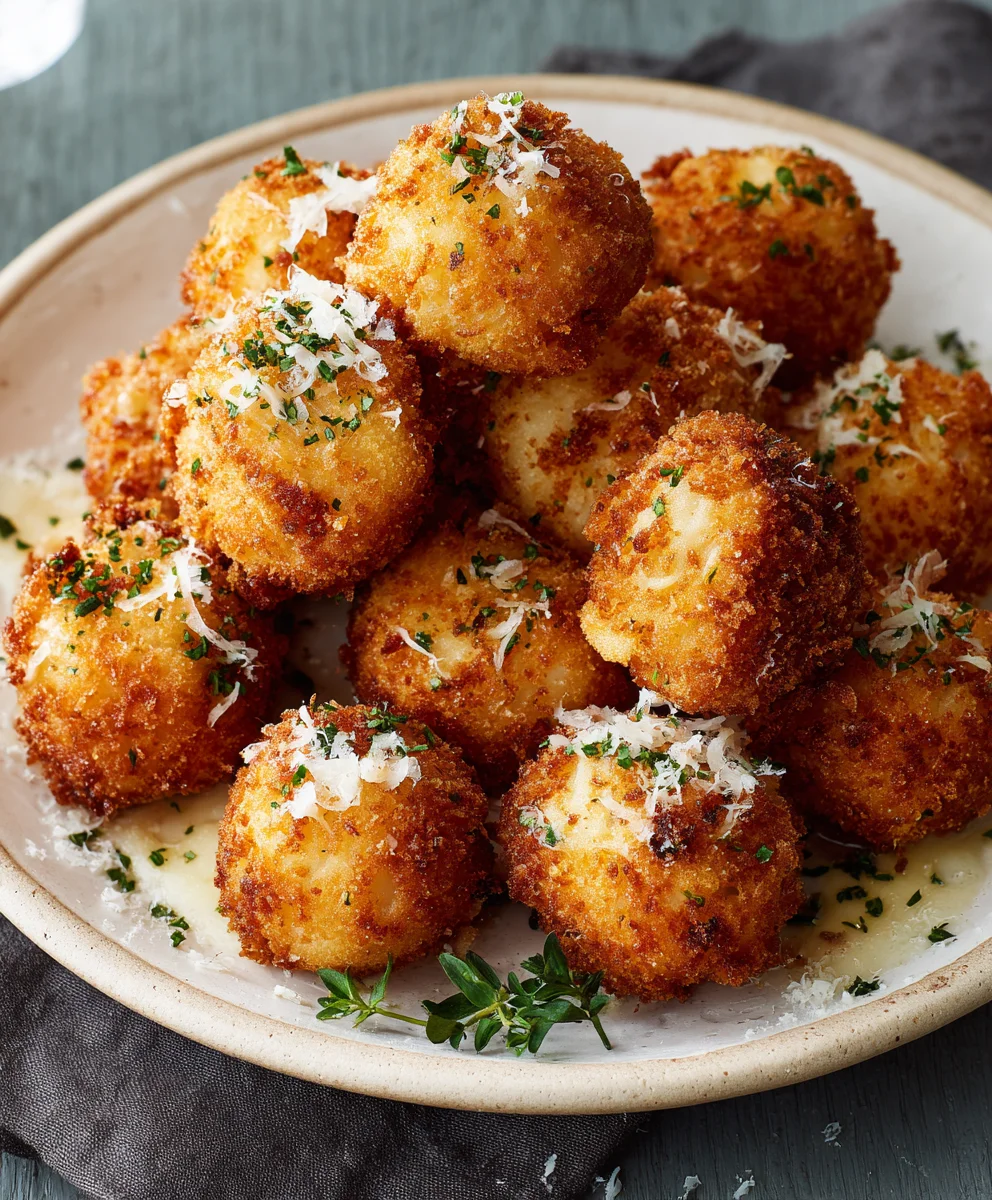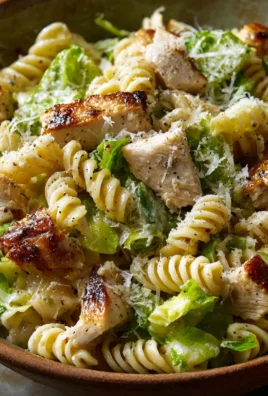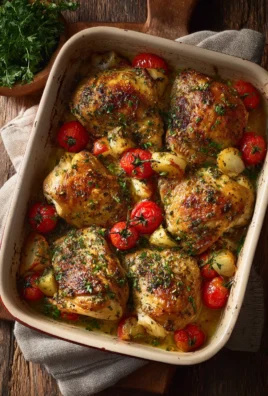Fried Cheese Balls are more than just a snack; they are a golden ticket to appetizer paradise. Imagine biting into a perfectly crisp, golden-brown exterior, only to be met with an incredibly warm, gooey, and irresistibly savory cheese melting in your mouth. This delightful contrast of textures and flavors makes them an instant crowd-pleaser at any gathering or a comforting treat for a cozy night in.
The Irresistible Allure of Melted Cheese
While the exact origin of the classic cheese ball remains a delicious mystery, variations of fried cheese have graced tables across the globe for centuries, from Greek saganaki to Italian mozzarella in carrozza. These bite-sized wonders transcend cultural boundaries, united by the universal love for melted cheese. We adore Fried Cheese Balls not only for their incredibly satisfying taste and comforting warmth but also for their surprising ease of preparation, making them a fantastic option for both novice and experienced home cooks. Get ready to impress your guests and satisfy your cravings with this iconic, cheesy indulgence.

Ingredients:
- For the Cheese Mixture:
- 2 cups (about 8 oz) freshly shredded low-moisture mozzarella cheese
- 1 cup (about 4 oz) freshly shredded sharp cheddar cheese
- ½ cup (about 2 oz) grated Parmesan cheese (the finely grated kind works best here)
- 4 oz cream cheese, softened to room temperature
- 1 teaspoon garlic powder
- ½ teaspoon onion powder
- ¼ teaspoon smoked paprika (optional, but adds a lovely depth)
- ¼ teaspoon black pepper, freshly ground
- ½ teaspoon salt (adjust to taste, as Parmesan is naturally salty)
- 2 tablespoons finely chopped fresh parsley or chives (optional, for flavor and color)
- For the Breading:
- 1 ½ cups all-purpose flour
- ½ teaspoon salt
- ¼ teaspoon black pepper
- 3 large eggs
- 2 tablespoons milk (any kind, dairy or non-dairy)
- 2 cups panko breadcrumbs (Japanese-style breadcrumbs for extra crispiness)
- For Frying:
- 4-6 cups vegetable oil, canola oil, or peanut oil (enough to submerge the cheese balls)
- For Serving (Optional):
- Marinara sauce, ranch dressing, or your favorite dipping sauce
Equipment You’ll Need:
- Large mixing bowl
- Medium-sized bowls (3 for the breading station)
- Shallow plates or pie dishes (also for breading, if preferred)
- Cookie scoop (1.5-inch diameter or a sturdy tablespoon)
- Baking sheet lined with parchment paper or wax paper (at least two, if possible)
- Large, heavy-bottomed pot or Dutch oven (for frying)
- Deep-fry thermometer
- Slotted spoon or spider strainer
- Wire cooling rack set over a baking sheet lined with paper towels
- Grater (if not using pre-shredded cheese, which I highly recommend against for best results)
Preparing the Cheese Mixture:
- Combine the Cheeses: In your large mixing bowl, gently combine the freshly shredded low-moisture mozzarella cheese, the sharp cheddar cheese, and the finely grated Parmesan cheese. It’s crucial to shred your own cheese if possible; pre-shredded varieties often contain anti-caking agents like cellulose, which can prevent the cheese from melting smoothly and consistently, ultimately impacting the gooey texture we desire for perfect Fried Cheese Balls. Use your hands or a sturdy spoon to ensure all three types of cheese are thoroughly and evenly mixed. This initial distribution is key for consistent flavor in every bite.
- Add Softened Cream Cheese and Seasonings: Now, add the softened cream cheese to the cheese mixture. Distribute the garlic powder, onion powder, smoked paprika (if using), freshly ground black pepper, and salt evenly over the cheese. If you’re incorporating fresh parsley or chives, add them at this stage as well, ensuring they are finely chopped to distribute their flavor and color throughout.
- Mix Thoroughly: Using your clean hands, gently but firmly mix all the ingredients together. This step requires a bit of dedication. Knead and press the mixture until the cream cheese is fully incorporated, acting as a binder for all the shredded cheeses and seasonings. You’ll want to continue mixing until it forms a cohesive, slightly sticky, dough-like ball that holds its shape well when pressed. This thorough mixing ensures uniform flavor and prevents any individual ingredient from standing out too much, leading to perfectly balanced Fried Cheese Balls.
- Chill the Mixture: Once the mixture is thoroughly combined, cover the bowl tightly with plastic wrap and refrigerate it for at least 30 minutes, or ideally up to 2 hours. This chilling step is absolutely vital and cannot be skipped. It allows the cream cheese to firm up slightly, making the entire mixture much easier to handle, scoop, and shape into uniform balls. More importantly, it helps the cheese balls maintain their integrity during the subsequent breading process and significantly reduces the risk of them disintegrating or bursting open in the hot oil. I promise, this short wait makes a monumental difference in the final product!
Forming the Fried Cheese Balls:
- Prepare Your Workspace: While the cheese mixture is chilling, take a moment to line a baking sheet with parchment paper or wax paper. This will be the temporary home for your perfectly formed cheese balls before they embark on their breading journey. Having this prepared in advance will help streamline your entire process.
- Scoop and Shape: Remove the chilled cheese mixture from the refrigerator. Using a 1.5-inch cookie scoop (which typically holds about 1 tablespoon of mixture) or simply a regular tablespoon, scoop out uniform portions of the cheese mixture. Consistency in size is important for even cooking.
- Roll into Balls: Gently roll each scooped portion between your palms to form a smooth, compact ball. Aim for balls that are roughly 1 to 1.5 inches in diameter. The key here is uniformity; try to make them as close in size as possible. This ensures that every cheese ball cooks at the same rate when fried, resulting in consistent crispiness and gooeyness. If your hands start to get too sticky from the cheese, you can lightly dust them with a little all-purpose flour or rinse them briefly with cold water to prevent sticking. Place each perfectly formed cheese ball onto the prepared baking sheet.
- Chill Again (Optional, but Highly Recommended): Once all the cheese mixture has been formed into these adorable little balls, return the baking sheet to the refrigerator for an additional 15-30 minutes. This extra chill time further solidifies the balls, making them even more resilient to handling during breading. It also ensures the core of the cheese is very cold, which helps it to melt slowly and evenly when it hits the hot oil, significantly reducing the chances of any cheese leaks or explosions during frying. This step is particularly helpful if your kitchen is warm or if you anticipate taking your time with the breading process. It’s another small effort that pays big dividends for robust Fried Cheese Balls.
Setting Up the Breading Station:
- Prepare the Flour Dredge: In the first of your three medium-sized bowls (or shallow plates, which often work better for rolling), combine the 1 ½ cups of all-purpose flour with ½ teaspoon of salt and ¼ teaspoon of black pepper. Take a moment to whisk these dry ingredients together thoroughly. This ensures the seasoning is evenly distributed, so every bite of your crispy coating is flavorful. This seasoned flour will be the crucial first layer, providing a dry, textured surface for the egg wash to firmly adhere to.
- Prepare the Egg Wash: In the second bowl, crack the 3 large eggs. Add the 2 tablespoons of milk. Vigorously whisk the eggs and milk together until the mixture is completely uniform, smooth, and slightly frothy. You want no visible streaks of yolk or white. This egg wash acts as the essential “glue” that will bind the breadcrumbs firmly to your Fried Cheese Balls, creating that robust, crispy crust.
- Prepare the Panko Breadcrumbs: In the third and final bowl, pour the 2 cups of panko breadcrumbs. I enthusiastically recommend using panko (Japanese-style breadcrumbs) over regular breadcrumbs for this recipe. Their larger, flakier, and more airy texture results in an exceptionally crispier coating, creating that incredibly satisfying crunch we all crave in a perfectly fried snack. Spread the breadcrumbs out evenly in the bowl to make dipping and coating easier and more efficient.
- Arrange Your Station: Arrange your three bowls in a logical assembly line fashion: start with the flour, then the egg wash, and finally the panko breadcrumbs. Position your baking sheet with the formed, chilled cheese balls at the beginning of this line, and your second clean, parchment-lined baking sheet (which will hold the breaded balls) at the very end. This organized setup is key to making the breading process efficient, clean, and stress-free.
The Breading Process:
- The First Coating (Flour): Take one chilled cheese ball from your prepared baking sheet and gently roll it in the seasoned flour mixture. Ensure it’s fully coated on all sides. After coating, lightly tap off any excess flour; you want just a thin, even layer. Too much flour can result in a gummy texture underneath the crust.
- The Second Coating (Egg Wash): Carefully transfer the flour-dusted cheese ball into the egg wash. Roll it around until it is completely covered with the egg mixture. Allow any excess egg to drip off briefly before proceeding to the next step. This step is absolutely critical for establishing a strong, lasting bond with the breadcrumbs.
- The Third Coating (Panko): Immediately transfer the egg-coated cheese ball into the panko breadcrumbs. Gently press and roll the ball in the panko, ensuring it is thoroughly covered from all angles. Press the breadcrumbs onto the ball firmly to create a thick, even coating. The more robustly you apply the breadcrumbs, the crispier and more protective your final crust will be.
- The Second Flour Coating (For Double Breading): Now, here’s a crucial step for extra crispiness and protection. Gently place the panko-coated ball back into the flour mixture. Roll it once more, lightly coating it in flour. This might seem slightly unconventional, but it’s a strategic part of our double-breading strategy, creating another layer of adhesion.
- The Second Egg Wash Coating: Immediately transfer the flour-dusted, panko-coated ball back into the egg wash for a second dip. Ensure it’s fully re-coated, then let any excess egg drip off once more.
- The Second Panko Coating (For Double Breading): Finally, transfer the ball back into the panko breadcrumbs for its second, final, and most substantial coat. Press the panko firmly onto the entire surface, ensuring every inch is thoroughly covered. This double-breading technique is the ultimate secret to exceptionally crispy Fried Cheese Balls that are incredibly resistant to leaking or bursting during the frying process. It creates a remarkably robust barrier, effectively locking in all that delicious, molten cheese within its golden shell.
- Repeat and Arrange: Place the fully double-breaded cheese ball onto your second parchment-lined baking sheet. Repeat this entire meticulous breading process (steps 13-18) for all the remaining cheese balls. Take your time to ensure each ball is perfectly and completely coated.
- Final Chill Before Frying: Once all your cheese balls are beautifully breaded, place the baking sheet back into the refrigerator for at least 30 minutes, or even an hour. This final chill is incredibly important. It gives the breading a chance to set firmly and ensures the cheese inside is very cold, which helps it to melt slowly rather than gush out immediately when it hits the hot oil. Do not skip this step under any circumstances! It’s a key factor in achieving perfect, non-exploding Fried Cheese Balls with a supremely gooey interior. As a bonus, you can even freeze them at this stage for later use; if freezing, flash freeze on the baking sheet until solid, then transfer to a freezer-safe bag or airtight container. You can then fry them directly from frozen, adding just a minute or two to the cooking time.
Preheating the Oil for Frying:
- Set Up Your Frying Pot: Pour the vegetable oil, canola oil, or peanut oil into your large, heavy-bottomed pot or Dutch oven. You need enough oil so that the cheese balls will be mostly, if not fully, submerged when frying. Typically, this means about 3-4 inches of oil depth, depending on the size of your pot. Using a heavy-bottomed pot helps maintain a consistent oil temperature.
- Attach Thermometer and Heat Oil: Securely attach a deep-fry thermometer to the side of the pot, ensuring the tip is submerged in the oil but not touching the bottom. Begin heating the oil gradually over medium-high heat. Patience here is a virtue; don’t rush the heating process.
- Achieve Optimal Temperature: Allow the oil to heat steadily until it reaches a consistent temperature of 350°F (175°C). Maintaining the correct oil temperature is absolutely paramount for achieving perfect Fried Cheese Balls. If the oil is too cold, the cheese balls will absorb an excessive amount of oil, resulting in a greasy, heavy, and less appetizing product. Conversely, if the oil is too hot, the breading will burn rapidly and turn too dark before the cheese inside has a chance to melt properly and become wonderfully gooey. Keep a vigilant eye on your thermometer and adjust the heat as needed throughout the entire frying process to ensure optimal results.
Frying Your Delicious Fried Cheese Balls:
- Fry in Batches: Once your oil has reached the precise temperature of 350°F (175°C), carefully remove your chilled, breaded cheese balls from the refrigerator. Gently lower 3-4 cheese balls into the hot oil using your slotted spoon or spider strainer. It is absolutely essential not to overcrowd the pot! Frying too many cheese balls at once will drastically lower the oil temperature, leading to undercooked, greasy, and significantly less crispy results. Patience is undoubtedly key for this step.
- Monitor and Turn: Fry the cheese balls for approximately 2-3 minutes, or until they have achieved a beautiful, even golden brown color on all sides. Use your slotted spoon to gently turn them periodically within the oil to ensure even coloring and consistent crispiness. During this process, you’ll notice them puffing up slightly as the cheese inside melts and creates steam, a clear sign of delicious transformation.
- Achieving Golden Perfection: The ultimate goal is a rich, appealing golden-brown crust that is incredibly crisp to the touch. As soon as they reach this desired stage, they are perfectly cooked. Resist the urge to over-fry them, as this can cause the cheese to eventually leak out or the breading to become overly dark and potentially burnt, diminishing the flavor and texture.
- Remove and Drain: Carefully remove the perfectly golden-brown Fried Cheese Balls from the oil using your slotted spoon or spider strainer. Hold them over the pot for a moment to allow any excess oil to drip back into the pot, minimizing greasiness.
- Transfer to Cooling Rack: Immediately transfer the hot, fried cheese balls to the prepared wire cooling rack, which should be set over a baking sheet lined with several layers of paper towels. The paper towels will effectively absorb any remaining excess oil, while the wire rack crucially allows air to circulate around the entire surface of the cheese balls, keeping the bottom crispy and preventing them from becoming soggy.
- Repeat for Remaining Batches: Before adding the next batch of cheese balls, allow the oil to return to the optimal temperature of 350°F (175°C). This might take a minute or two, so resist the urge to rush. Continue frying in small, controlled batches until all your delicious Fried Cheese Balls are perfectly cooked, golden, and ready for enjoyment.
Draining and Serving:
- Serve Immediately: While they are undeniably tempting to devour straight from the fryer, give them just a minute or two on the cooling rack to allow their internal temperature to equalize slightly. This brief rest helps prevent burns from overly hot cheese and allows the molten cheese to set just enough to be wonderfully gooey without being scalding hot.
- Present with Dips: Artfully arrange your golden-crisp Fried Cheese Balls on a serving platter. They are unequivocally best served warm, ideally with an accompaniment of your favorite dipping sauces. A classic, robust marinara sauce is always a beloved winner, but creamy ranch dressing, a tangy honey mustard, or even a sophisticated spicy aioli can truly elevate the entire experience. For an added touch of elegance and flavor, don’t forget a final sprinkle of freshly chopped parsley or a dusting of finely grated Parmesan cheese over the top, which adds both visual appeal and an extra burst of savory goodness. Enjoy the fruits of your labor!
Tips for Perfect Fried Cheese Balls:
- Cheese Quality Matters Immensely: Always opt for block cheese that you take the time to shred yourself. Pre-shredded cheeses often contain anti-caking agents like cellulose, which inhibit smooth melting and can unfortunately result in a slightly grainy or less gooey texture in your Fried Cheese Balls.
- Chill Thoroughly and Repeatedly: The multiple chilling steps outlined in this recipe are non-negotiable. A very cold cheese mixture and even colder breaded balls are paramount to preventing internal cheese leakage and ensuring the cheese melts slowly and beautifully within its wonderfully crispy, golden shell.
- Double Breading is Your Staunch Friend: This meticulous technique creates a significantly thicker, more durable, and more protective crust. This superior barrier provides robust protection against cheese leakage during the high-heat frying process, leading to a much more successful and satisfying end product.
- Maintain Precise Oil Temperature: Always use a reliable deep-fry thermometer and be prepared to adjust your heat as necessary throughout the frying process. Consistent oil temperature (350°F/175°C) is arguably the single most important factor for achieving a perfectly golden, uniformly crispy exterior without a greasy interior.
- Do Not Overcrowd the Pot: Frying in small, manageable batches is crucial. This ensures that the oil temperature doesn’t drop too significantly, which is absolutely vital for even cooking, consistent crispiness, and preventing the cheese balls from becoming oil-logged.
- Season Your Breading Layers: Never forget to season your flour dredge! This simple step adds another delightful layer of flavor directly to the crust, making your Fried Cheese Balls even more delicious and well-rounded from the very first bite.
- Get Creative with Seasonings: Feel entirely free to experiment with the cheese mixture beyond the basic recipe. A pinch of red pepper flakes can add a welcome kick, a dash of dried oregano can lend an Italian-inspired twist, or even some finely crumbled cooked bacon or a hint of truffle zest can add exciting, gourmet variations to your cheese balls.
- Freezing for Future Enjoyment: If you wish to prepare a larger batch of these delectable treats in advance, you can easily freeze the double-breaded cheese balls. Once fully breaded and chilled, flash freeze them on a baking sheet until they are solid. Then, transfer them to a freezer-safe bag or airtight container. You can then fry them directly from frozen, simply adding an extra minute or two to the frying time and ensuring the internal cheese is thoroughly melted and gooey.

Conclusion:
So there you have it, my friends! We’ve journeyed through the simple steps to create an absolute culinary triumph. If you’ve been looking for that one appetizer that truly steals the show, that disappears from the plate faster than you can say ‘delicious,’ then this recipe for Fried Cheese Balls is absolutely your answer. I promise you, these aren’t just any fried cheese balls; they are perfectly crispy on the outside, giving way to a warm, gooey, utterly irresistible interior that stretches delightfully with every bite. The blend of cheeses, often a secret weapon in my kitchen, melts into a creamy, savory dream, seasoned just right to tantalize your taste buds. This isn’t a complicated recipe, far from it. It’s designed for joy, for those moments when you want to impress without the stress, to bring a smile to everyone’s face, including your own. The satisfaction of pulling a golden-brown, perfectly spherical cheese ball from the oil, knowing the delicious surprise awaiting inside, is truly one of life’s little pleasures. It’s an experience, really, a little piece of comfort food heaven that’s surprisingly quick to achieve. You’ll wonder why you ever bought frozen appetizers again. Trust me on this: these are not just good; they are phenomenal, a real game-changer for your party menu or even just a cozy night in.
Elevate Your Fried Cheese Ball Experience: Serving Suggestions & Creative Twists
Now, while these delightful morsels are fantastic on their own, a truly great dish often comes with versatile serving options. For a classic approach, I love serving my Fried Cheese Balls with a warm bowl of rich marinara sauce. The tangy tomato perfectly cuts through the richness of the cheese, creating a harmonious balance. But don’t stop there! Imagine them alongside a creamy ranch dressing, a zesty honey mustard, or even a sweet and spicy chili sauce for an exciting kick.
Garnishes and Dips Galore:
A sprinkle of fresh chopped parsley or chives right before serving adds a touch of color and a fresh aroma that truly elevates the presentation. For those who love a bit of heat, a dash of red pepper flakes in the breading or a side of sriracha mayo can be a fantastic addition.
Unleash Your Inner Chef: Variations to Explore:
Feeling adventurous? The beauty of this recipe lies in its adaptability. While I’ve given you a foolproof classic, feel free to experiment with different cheese blends. Imagine the sharpness of aged cheddar mingling with the melty goodness of Monterey Jack, or perhaps the salty tang of feta crumbled into the mix for a Mediterranean twist. For a truly gourmet touch, a small amount of goat cheese can add a sophisticated creaminess and unique flavor profile. Want to add more texture or a hint of spice? Finely chopped jalapeños, a pinch of smoked paprika, or even some crispy bacon bits can be folded into the cheese mixture before shaping. You could even try different breading varieties – panko breadcrumbs give an extra crispy texture, while a cornmeal coating offers a rustic crunch. And who says they have to be spheres? Experiment with logs, flattened patties, or even small triangles for a unique presentation. These variations ensure that your Fried Cheese Balls can be tailored to any occasion, any palate, and truly become your signature dish.
So, my dear readers, what are you waiting for? I genuinely hope you feel inspired to roll up your sleeves and give this incredible recipe a try. It’s more than just cooking; it’s about creating moments, sharing joy, and savoring the simple pleasures of homemade goodness. Don’t just read about these amazing Fried Cheese Balls; make them! I promise, the effort is minimal, and the reward is absolutely immense. Once you’ve whipped up your batch of golden, gooey perfection, I would absolutely love to hear all about your experience. Did you try a new cheese blend? Discover a fantastic dipping sauce combination? Please, share your culinary adventures, your photos, your triumphs, and even your funny kitchen anecdotes in the comments below. Let’s build a community of enthusiastic home cooks who aren’t afraid to indulge in a little fried cheesy goodness. Happy cooking, and I can’t wait to see what deliciousness you create!

Fried Cheese Balls
Fried Cheese Balls combine a crispy exterior with a gooey, cheesy center for the perfect bite every time. The seasoned coating adds a flavorful kick, while the melted cheddar and mozzarella provide creamy goodness. Whether you’re hosting a party or enjoying a cozy snack, these are a guaranteed hit.
Ingredients
-
1 cup (113g) freshly shredded low-moisture mozzarella cheese
-
1 cup (113g) freshly shredded sharp cheddar cheese
-
½ cup (2 oz) grated Parmesan cheese
-
4 oz cream cheese, softened
-
1 tsp garlic powder
-
½ tsp onion powder
-
¼ tsp smoked paprika (optional)
-
¼ tsp black pepper, freshly ground
-
½ tsp salt
-
2 tbsp finely chopped fresh parsley (optional)
-
½ cup (60g) all-purpose flour
-
½ tsp salt (for breading)
-
¼ tsp black pepper (for breading)
-
3 large eggs
-
2 tbsp milk
-
½ cup (30g) panko breadcrumbs
-
4 cups (960ml) vegetable oil
-
Marinara sauce (optional, for serving)
Instructions
-
Step 1
In a large bowl, combine shredded mozzarella, cheddar, Parmesan, softened cream cheese, garlic powder, onion powder, smoked paprika, black pepper, salt, and optional parsley. Mix thoroughly until cohesive. -
Step 2
Cover and refrigerate the cheese mixture for at least 30 minutes. -
Step 3
Line a baking sheet with parchment paper. Scoop 1.5-inch portions of chilled cheese mixture and roll into smooth balls. Place on the prepared baking sheet. -
Step 4
Refrigerate formed cheese balls for an additional 15-30 minutes. -
Step 5
Set up a breading station: Bowl 1: whisk ½ cup (60g) all-purpose flour with ½ tsp salt and ¼ tsp black pepper. Bowl 2: whisk 3 large eggs with 2 tbsp milk. Bowl 3: spread ½ cup (30g) panko breadcrumbs. -
Step 6
Double bread the cheese balls: Roll each ball in seasoned flour, then egg wash, then panko. Repeat flour, egg wash, and panko steps for a second coating. Press breadcrumbs firmly. Place on a clean parchment-lined baking sheet. -
Step 7
Refrigerate all breaded cheese balls for at least 30 minutes. (Can freeze at this stage for later use; fry directly from frozen, adding a minute or two to cook time). -
Step 8
In a heavy-bottomed pot, heat 4 cups (960ml) vegetable oil to 350°F (175°C) using a deep-fry thermometer. -
Step 9
Fry cheese balls in small batches (3-4 at a time) for 2-3 minutes, turning until golden brown and crispy. Do not overcrowd, allow oil to return to temperature between batches. -
Step 10
Remove from oil with a slotted spoon, drain excess oil, and transfer to a wire cooling rack set over paper towels. -
Step 11
Serve immediately after a brief rest, with optional marinara sauce or other dips.
Important Information
Nutrition Facts (Per Serving)
It is important to consider this information as approximate and not to use it as definitive health advice.
Allergy Information
Please check ingredients for potential allergens and consult a health professional if in doubt.




Leave a Comment